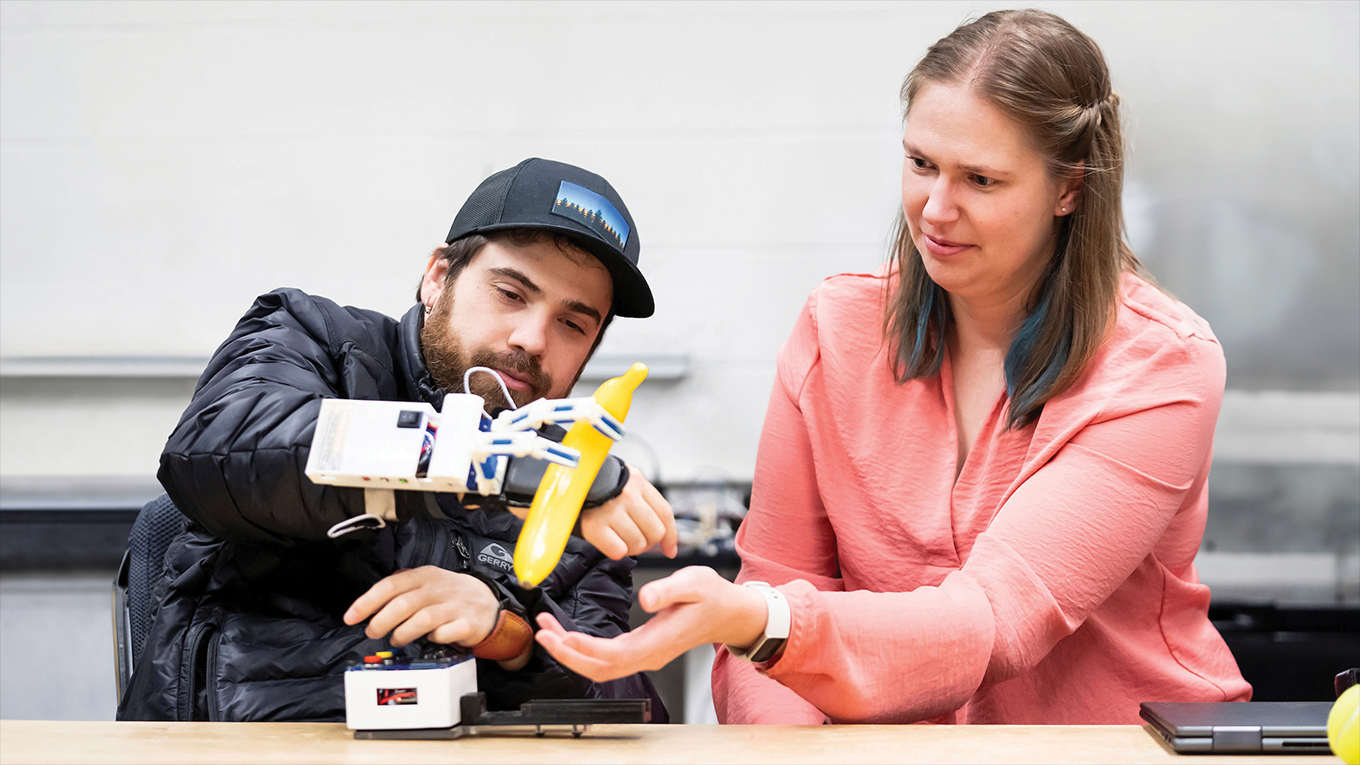 Drew McPherson and Hannah Stuart demonstrate the newest version of the Dorsal Grasper in the Embodied Dexterity Group’s lab. (Photo by Adam Lau/Berkeley Engineering)
Drew McPherson and Hannah Stuart demonstrate the newest version of the Dorsal Grasper in the Embodied Dexterity Group’s lab. (Photo by Adam Lau/Berkeley Engineering)Q+A on assistive devices
More than 15 million people worldwide are living with spinal cord injury (SCI), which can affect sensory and motor functions below the injury level. For some, this can mean limited voluntary finger and wrist flexion, making it difficult to grasp large, heavy objects. Now, mechanical engineering associate professor Hannah Stuart, Ph.D. student Andrew “Drew” McPherson and postdoctoral researcher Jungpyo Lee have developed a wearable device to enhance grasping functionality in this population. Dubbed the Dorsal Grasper, this device leverages voluntary wrist extension and uses supernumerary robotic fingers on the back of the hand to facilitate human-robot collaborative grasping.
What’s unique about the Dorsal Grasper?
HS: We designed the Dorsal Grasper to enable what we call collaborative grasping. People with tetraplegia will often retain the ability to extend the wrist backward but don’t have the ability to flex it forward, so they have this directionality. And people can be strong in their wrist, in extension, and that’s an important part of daily function. We wanted to enhance that capability by enabling grasping, but in such a way that the person is an active partner in the grasp. A unique feature is the device’s use of robotic fingers to grasp with the back of the hand. Today, robotic wearables often fit around the person’s fingers, which creates a tension between what the person and the robot each want to do. With supernumerary grasping, both the person and robot are free to act as they see fit.
DM: This population generally uses wheelchairs to get around. And with limited trunk control and overall body mobility, graspable workspace, or being able to reach things off a counter, is really restricted. This device stands out in that you can grasp with one hand pretty much anywhere you can reach that arm.
How does it advance the field of assistive technology?
DM: A lot of devices seek to replace or do the same type of grasping that people are doing already, and the Dorsal Grasper isn’t trying to do that at all. I haven’t seen a lot of devices that adequately support intent detection, which is a significant challenge within the field. With Dorsal Grasper, we’re able to use people’s residual strength and their ability to move their wrist. That partial body power allows the device to read their intention to grab things, which allows for fewer false positives, or fewer accidental grasps. And this then makes it a little bit easier to use the device. We’re not simply creating tasks that highlight the benefits of the robot, but rather we’re looking at ways that this device might be able to help someone in real life. Often this process involves applying my own lived experience as a person with SCI.
What did you learn from your latest in-lab tests?
JL: We found that subjects could reach their hand out and rotate their hand a lot. So they could simply rotate their head to see the location and then easily grasp the object. This was possible because the robotic finger could be controlled with just wrist extension, something they use all the time. The person is a partner, controlling the robotic finger and wrist extension. Compared to a fully robotic system, the Dorsal Grasper allows for a faster response.
HS: And we achieved such intuitive operation without relying on any fancy components, like EMG [electromyography] sensors or neural interfaces.
How has the user experience shaped the device’s development?
HS: We’ve grown an appreciation for the abilities that a person has in the absence of the device that we’re introducing. Our testing allows us to then see if the introduction of the device might negatively impact them or add new abilities. So we specifically included evaluation of people wearing the device but not using it.
DM: It’s important to look at how people adapt. How they might come up with different grasps. If we develop a device that might get in the way of how they do things already, they might be getting a net negative rather than a net positive in terms of being able to do something. And that will have a real impact on whether they use the device.
Learn more: New assistive device enhances grasping for people with spinal cord injuries; Expanding functional workspace for people with C5-C7 spinal cord injury with supernumerary dorsal grasping (IEEE Transactions on Neural Systems and Rehabilitation Engineering)
